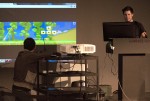Some games are not as commercial-friendly as “Call of Duty” or “Gears of War.” Some games won’t reach as large an audience as “Need for Speed” or “Assassin’s Creed.” But those games are no less innovative, and are often more so. And they have a place at the UCLA Game Art Festival.
UCLA Game Lab Manager David Elliott said the festival is a showcase of independent games, from video games to table games, and also of artwork that is inspired by games or uses games as a form of expression. Elliott said that, over the course of the festival’s three and a half hours, between 35 and 40 games will be on display, in both a live arcade and a demo zone.
Elliott said that one remarkable quality of the festival is its international makeup of game artists. In addition to game developers from the United States, the festival will feature games by artists from Switzerland, Canada and Germany, as well as others.
“The works being shown are a cross section that spans globally. … We’re curating on a global scale,” Elliott said.
One of those international creations is “Mimicry,” a work by two alumni of the Geneva University of Art and Design, Raphaël Muñoz and Emilie Tappolet. “Mimicry” takes advantage of a technology known as faceshift, which Munoz said tracks and notes movements in the muscles of the user’s face.
“Mimicry” takes inspiration from the paintings of Caspar David Friedrich, a 19th-century Romantic painter known for his landscapes. One of those, “Wanderer above the Sea of Fog,” features a lone figure looking out at nature. The painting has inspired the opinion that the figure’s mood is reflected in the environment before him. Muñoz said that he and Tappolet took this idea and expanded on it in their current exhibition, in which players’ facial movements and mood are reflected in the painting before them.
“We can map the feelings of the visitor in the landscape, so that’s why, when you smile and look at the screen, the sun is shining,” Munoz said.
“Mimicry” is not the only game that takes the motions of the user as a basis for the game’s content. One other such game, Elliott said, is “Perfect Woman,” a collaboration by artist and designer Lea Schoenfelder and programmer and designer Peter Lu, currently in residence at the UCLA Game Lab. “Perfect Woman,” Elliott said, challenges the player to be the “perfect woman” by selecting and holding various physical positions that correspond to life choices within the game.
In addition to the work of international game developers, the UCLA Game Art Festival will feature works by UCLA students. Another project on exhibit is fourth-year Design | Media Arts student Aliah Magdalena Darke’s “Objectif.” Darke said that the game is played similar to Apples to Apples, and is made of cards with different faces on them that players judge. She said that the game forces viewers and players to challenge their perceptions of beauty.
Elliott said that the festival’s influence and quality is only expanding as a receptacle for exciting independent games, both for members of the international community and aspiring game developers here in Los Angeles.
“We want to create a venue for highly experimental works to be showcased, … works that get pushed to the side in other more mainstream festivals and contests,” Elliott said.
